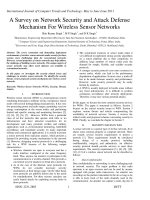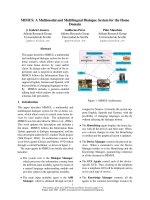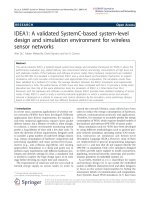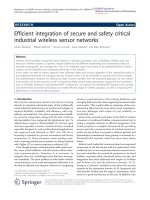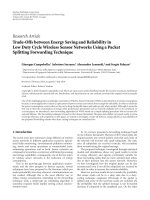DESIGN AND IMPLEMENTATION OF WEB-BASED DATA AND NETWORK MANAGEMENT SYSTEM FOR HETEROGENEOUS WIRELESS SENSOR NETWORKS
Bạn đang xem bản rút gọn của tài liệu. Xem và tải ngay bản đầy đủ của tài liệu tại đây (1.67 MB, 104 trang )
Graduate School ETD Form 9
(Revised 12/07)
PURDUE UNIVERSITY
GRADUATE SCHOOL
Thesis/Dissertation Acceptance
This is to certify that the thesis/dissertation prepared
By
Entitled
For the degree of
Is approved by the final examining committee:
Chair
To the best of my knowledge and as understood by the student in the Research Integrity and
Copyright Disclaimer (Graduate School Form 20), this thesis/dissertation adheres to the provisions of
Purdue University’s “Policy on Integrity in Research” and the use of copyrighted material.
Approved by Major Professor(s): ____________________________________
____________________________________
Approved by:
Head of the Graduate Program Date
Q
un Yu
Design and Implementation of Web-based Data and Network Management System for
H
eterogeneous Wireless Sensor Networks
M
aster of Science
Y
ao Liang
X
ukai Zou
Y
uni Xia
Yao Liang
Shiaofen Fang 22th July 2010
Graduate School Form 20
(Revised 1/10)
PURDUE UNIVERSITY
GRADUATE SCHOOL
Research Integrity and Copyright Disclaimer
Title of Thesis/Dissertation:
For the degree of ________________________________________________________________
I certify that in the preparation of this thesis, I have observed the provisions of Purdue University
Teaching, Research, and Outreach Policy on Research Misconduct (VIII.3.1), October 1, 2008.*
Further, I certify that this work is free of plagiarism and all materials appearing in this
thesis/dissertation have been properly quoted and attributed.
I certify that all copyrighted material incorporated into this thesis/dissertation is in compliance with
the United States’ copyright law and that I have received written permission from the copyright
owners for my use of their work, which is beyond the scope of the law. I agree to indemnify and save
harmless Purdue University from any and all claims that may be asserted or that may arise from any
copyright violation.
______________________________________
Printed Name and Signature of Candidate
______________________________________
Date (month/day/year)
*Located at
/>D
esign and Implementation of Web-based Data and Network Management System for
H
eterogeneous Wireless Sensor Networks
Master of Science
Q
UN YU
07/23/2010
DESIGN AND IMPLEMENTATION OF WEB-BASED DATA AND NETWORK
MANAGEMENT SYSTEM FOR HETEROGENEOUS WIRELESS SENSOR
NETWORKS
A Thesis
Submitted to the Faculty
of
Purdue University
by
Qun Yu
In Partial Fulfillment of the
Requirements for the Degree
of
Master of Science
August 2010
Purdue University
Indianapolis, Indiana
ii
ACKNOWLEDGMENTS
This thesis would not have been possible without the help and support of
many people. I would like to express my deepest gratitude to my adviser, Prof.
Yao Liang. His supervision helped expedite my research progresses and open
the door to new discoveries.
I also, would like to thank my committee members Prof. Yuni Xia and Prof.
Xukai Zou for their time and guidance. In addition, I would like to thank Prof.
Arjan Durresi, Prof. Yuni Xia, Prof. Xukai Zou and Prof. Rajeev Raje for their
wonderful courses. I learned a lot from these inspiring classes, and have applied
what I gained in these classes to my research work.
I am also thankful to many department staff, including, but not limited to,
Joshua, Nicole, DeeDee and Scott and all people and students, especially Rui
Liu, Wei Zhao, from my department, for their patience and help as they came
along with me during this process.
Finally, I would like to thank my parents for their love and support.
iii
TABLE OF CONTENTS
Page
LIST OF TABLES V
LIST OF FIGURES Vii
ABBREVIATIONS iX
ABSTRACT Xi
CHAPTER 1. INTRODUCTION 1
1.1. Research Background 1
1.2. Research Goal 2
CHAPTER 2. RELATED WORK 3
2.1. Current Sensor Network Platforms 3
2.1.1. MoteWorks Platform 3
2.1.2. Particle Platform 4
2.1.3. μNode Platform 4
2.2. Sensor Network Middleware Architectures 5
2.2.1. MoteView Framework 6
2.2.2. Atlantis Framework 6
2.2.3. Decentralized Enterprise Systems Framework 6
CHAPTER 3. H-WSNMS ARCHITECTURE 8
3.1. H-WSNMS System Framework Overview 8
3.2. Management Service and Application Layer 12
3.2.1. Service Components 13
3.2.2. MSA Metadata Repository 14
3.3. Unified Gateway Layer 16
3.3.1. UG Metadata Repository 18
3.3.2. Service Proxy 19
3.3.3. Gateway Access 19
3.3.4. Communication Mechanism 20
3.4. Mote Layer 20
3.5. H-WSNMS DB 20
3.6. System General Function Logical Flow 21
CHAPTER 4. H-WSNMS KEY TECHNOLOGIES AND IMPLEMENTATION 23
4.1. System Logical Architecture and Key Technologies Overview 23
4.2. Mapping Fame 24
4.2.1. Mapping Model Technology 24
4.2.2. Virtual Command Set Mapping Model 24
4.2.3. VCSMM Application Case Discussion 27
iv
Page
4.3. Access Adaption 30
4.3.1. Unified Gateway Access Technology 30
4.3.2. Unified Gateway Access Model 32
4.4. H-WSNMS Implementation 33
4.4.1. H-WSNMS Software Architecture Overview 33
4.4.2. System User Interface Design 35
4.4.3. XML Template and Definition 35
4.4.4. Data Structure and Definition 40
CHAPTER 5. H-WSNMS CASE STUDY 42
5.1. Experiment Hardware 42
5.2. Software Platform 45
5.2.1. Client Tier 45
5.2.2. Specific Gateway Middleware 46
5.3. Main Functions Overview 48
5.3.1. Monitoring Function and Demo 50
5.3.2. Configuration Function and Demo 54
5.3.3. Reprogram Function and Demo 59
5.3.4. Data Collection Function and Demo 64
5.4. XServe’s Extension 69
CHAPTER 6. FUTURE WORK 72
LIST OF REFERENCES 74
APPENDICES
Appendix A 77
Appendix B 79
Appendix C 84
Appendix D 86
Appendix E 88
v
LIST OF TABLES
Table Page
Table 3.1 Virtual Command Category and Specification of VCS 15
Table 4.1 General Wrapped XML Format 29
Table 4.2 Wrapped XML Template File and Mapped Command String 36
Table 4.3 Specification of Code 37
Table 4.4 Data Collection Service Configuration XML Template File 39
Table 4.5 Monitoring Service Configuration XML Template File 40
Table 5.1 Sensor Boards and Motes 44
Table 5.2 Monitoring Request XML File and Mapped Command String 51
Table 5.3 Configuration Request XML File and Mapped Command String 56
Table 5.4 Reprogram Request XML File and Mapped Command String 61
Table 5.5 Data Collection Request XML File and Mapped Command String 66
Appendix Table
Table A.1 Parameters Definition 77
Table A.2 Command Category and Specification of VCS 78
Table B.1 XServe Command Line Parameters 79
Table B.2 XServe Configuration Command Line Parameters 80
Table B.3 XServeTerm Line Parameters 80
Table B.4 XServeTerm Available Parameters 81
Table B.5 XCommand Categories and Description 82
Table B.6 XServe Reprogram Line Parameters 82
Table B.7 XOtap Command Arguments 83
Table C.1 Monitoring ServiceID Definition 84
Table C.2 Configuration ServiceID Definition 84
vi
Appendix Table Page
Table C.3 Reprogram ServiceID Definition 85
Table C.4 Data Collection ServiceID Definition 85
Table D.1 DataTable H-WSNMS_ServicInfor 86
Table D.2 Datatable H-WSNMS_PlatformState 86
Table D.3 Datatable H-WSNMS_SocketInfor 87
Table D.4 Datatable H-WSNMS_GatewayConfig 87
vii
LIST OF FIGURES
Figure Page
Figure 2.1 Sensor Platform: MICAz 3
Figure 2.2 Sensor Platform: Particle 4
Figure 2.3 Sensor Platform: μNode 5
Figure 3.1 H-WSNMS System Architecture 9
Figure 3.2 H-WSNMS with Virtual Command Set 11
Figure 3.3 Management Service and Application Layer 13
Figure 3.4 Unified Gateway Layer 17
Figure 3.5 General control and status information flow for Generic Functions 22
Figure 4.1 H-WSNMS System Logic Architecture 23
Figure 4.2 Virtual Command Set Mapping Module (VCSMM) 26
Figure 4.3 VCSMM Mapping Flow 27
Figure 4.4 VCSMM Application 28
Figure 4.5 Comparison of Service Access Modes 30
Figure 4.6 H-WSNMS Software Design 34
Figure 5.1 Mote Hardware 43
Figure 5.2 Three-tier architecture instantiation based on XServe 45
Figure 5.3 Gateway Middleware: XServe 46
Figure 5.4 User Profile of H-WSNMS 49
Figure 5.5 “Monitoring” Command Logical Flow 50
Figure 5.6 “Monitoring” UI 52
Figure 5.7 Demo of “Monitoring” 53
Figure 5.8 “Configuration” Command Logical Flow 54
Figure 5.9 “Configuration” UI 58
viii
Figure Page
Figure 5.10 Demo of “Get Config” 58
Figure 5.11 “Reprogram” Command Logical Flow 59
Figure 5.12 “Reprogram” UI 63
Figure 5.13 Demo of “Query” 63
Figure 5.14 “Data Collection” Command Logical Flow 64
Figure 5.15 “Data Collection” UI 68
Figure 5.16 Demo of “Data Collection” 68
Figure 5.17 Demo of “New Data Collection” 69
Figure 5.18 XServe Command Flow Illustration [2] 70
Figure 5.19 XServe Configuration Command Extension 71
Appendix Figure
Figure E.1 the Whole Design of H-WSNMS 88
ix
ABBREVIATIONS
ABBREVIATIONS DESCRIPTION
GW Gateway
GWS Gateway Set
H-WSNMS Heterogeneous Wireless Sensor
Networks Management System
MR Metadata Repository
MSA Management Service and Application
OTAP Over-the-air Programming
SC Service Component
SOA Service Oriented Architecture
TC Target Command
TCS Target Command Set
UG Unified Gateway
UGA Unified Gateway Access
VC Virtual Command
VCA Virtual Command Attributes
x
VCAS Virtual Command Attributes Set
VCC Virtual Command Category
VCS Virtual Command Set
VCSMM Virtual Command Set Mapping Model
WSN Wireless Sensor Network
WSNs Wireless Sensor Networks
XML Extensible Mark-up Language
xi
ABSTRACT
Yu, Qun. M.S., Purdue University, August, 2010. Design and Implementation of
Web-based Data and Network Management System for Heterogeneous Wireless
Sensor Networks. Major Professor: Yao Liang.
Today, Wireless Sensor Networks (WSNs) are forming an exciting new area
to have dramatic impacts on science and engineering innovations. New WSN-
based technologies, such as body sensor networks in medical and health care
and environmental monitoring sensor networks, are emerging. Sensor networks
are quickly becoming a flexible, inexpensive, and reliable platform to provide
solutions for a wide variety of applications in real-world settings. The increase in
the proliferation of sensor networks has paralleled the use of more
heterogeneous systems in deployment. In this thesis, our work attempts to
develop a new network management and data collection framework for
heterogeneous wireless sensor networks called as Heterogeneous Wireless
Sensor Networks Management System (H-WSNMS), which enables to manage
and operate various sensor network systems with unified control and
management services and interface.
The H-WSNMS framework aims to provide a scheme to manage, query,
and interact with sensor network systems. By introducing the concept of Virtual
Command Set, a series of unified application interfaces and Metadata (XML
files) across multiple WSNs are designed and implement the scalability and
flexibility of the management functions for heterogeneous wireless sensor
networks, which is demonstrated though through a series of web-based WSN
management Applications such as Monitoring, Configuration, Reprogram, Data
xii
Collection and so on. The tests and application trials confirm the feasibility of our
approach but also still reveal a number of challenges to be taken into account
when deploying wireless sensor and actuator networks at industrial sites, which
will be considered by our future research work.
.
1
CHAPTER 1. INTRODUCTION
1.1. Research Background
A wireless sensor network (WSN) [1] consists of spatially distributed
autonomous sensors cooperatively monitor physical or environmental conditions,
such as temperature, sound, vibration pressure motion or pollutants. The
development of wireless sensor networks (WSNs) was motivated by military
applications such as battlefield surveillance. They are now used in many
industrial and civilian application areas, including industrial process monitoring
and control, machine health monitoring, environment and habitat monitoring,
healthcare applications, home automation and traffic control and so on.
Wireless Sensor Networks have become an emerging new research area in
the distributed computing environment. It plays an important role in the pervasive
computing to support a wide range of applications of the daily life in future. So
far, as heterogeneous WSNs are being widely deployed for various applications,
we are faced with a new challenge of network management for heterogeneous
WSNs. On one hand, current available WSN management tools are either
application specific, or platform specific, thus suffering from the lack of reusability
in heterogeneous WSNs management environment. On the other hand, to
develop a new WSN management system for heterogeneous WSNs from scratch
is time consuming and may not be feasible. Motivated by such a challenge, a
major impediment in the integration process is represented by the variety of
customized platforms and proprietary technologies. In this thesis, we propose a
unique, open, scalable and flexible WSN Management Comprehensive
Application Platform targeted for Heterogeneous WSNs Management System.
2
Our prototype system H-WSNMS provides a Web-based Data and Network
Management Environment for Heterogeneous Wireless Sensor Networks.
This research topic is very important to allow large-scale heterogeneous
WSNs to be effectively and easily managed and operated in the real-world tasks
and applications.
1.2. Research Goal
In this thesis, our main goal is to put forward a Heterogeneous WSNs
management system solution scheme and implement it based on a prototype
environment. This system should have the following features as described:
• A unique, open, scalable and flexible WSN Management Comprehensive
Application Platform Architecture
• A Service Oriented WSN management platform
• A scalable Unified Gateway across multiple WSNs
In the design of our H-WSNMS architecture, some key component designs
are involved, such as Service Mapping design and Unified Gateway Access
design. In this thesis, we adopted the application of the Extensible Mark-up
Language (XML) which enables a new level of interoperability for heterogeneous
IT systems.
Using a common reference model improves this process and leads to
Virtual Command Set Mapping Model (VCSMM): Service Mapping. The results
can be used immediately to configure mediation layers integrating services into
an overall service oriented architecture. Besides, the Unified Gateway Access is
designed for integrating various different wireless sensor platforms and
accessing the third part gateway interfaces with other standards, which is flexible
and extendable.
3
CHAPTER 2. RELATED WORK
2.1. Current Sensor Network Platforms
2.1.1. MoteWorks Platform
Crossbow [4] was one of the first suppliers of the Berkeley-style MICA
motes [4] which employ the TinyOS operating system. Follow on products
include the MICA2 [4] (868/916 MHz) and MICAz (2.4 GHz) motes as shown in
Figure 2.1, and the Intel-designed IMOTE2. Crossbow also makes a software
design platform for its hardware called MoteWorks.
The MICA2 Mote is a third generation mote module used for enabling low-
power, wireless sensor networks. The MICA2 processor radio is fully supported
by the MoteWorks Software Platform.
MICAz is a wireless sensor network mote developed by Crossbow
Technology. The device is built upon the IEEE 802.15.4 standard. It is one of the
most commonly used mote system in the world.
Figure 2.1 Sensor Platform: MICAz
4
2.1.2. Particle Platform
The Particle node [13], produced by Particle Computer, comprises a
communication board with the PIC18f6720 microcontroller and TR1001
transceiver. Various types of sensors can be attached to the communication
board. The wireless communication uses the AwareCon protocol [20], which is
designed to handle high mobility and density of nodes. This makes the Particle
platform as shown in Figure 2.2 well suited for equipping chemical containers
handled by human operators and checking potential dangerous situations.
Figure 2.2 Sensor Platform: Particle
2.1.3. μNode Platform
The μNode platform [14] as shown in Figure 2.3, produced by Ambient
Systems, represents a low-power, general purpose sensor node, built around the
MSP430 microcontroller and a single- chip radio transceiver for the 433/868/915
MHz ISM band. After deployment, the μNodes self-organize into a multi-hop
network, through which data can be routed back and forth to a designated sink
node. This platform is ideal for building large-scale sensing infrastructures that
can function unattended for long periods of time. Since many chemicals must be
5
stored under specific ambient conditions, we use the μNode sensors for
continuously monitoring environmental conditions.
Figure 2.3 Sensor Platform: μNode
2.2. Sensor Network Middleware Architectures
Some of the "hot" topics in WSN software research include such as
Security, Mobility (when sensor nodes or base stations are moving) and
Middleware (the design of middle-level primitives between the software and the
hardware). This thesis focuses on the research on sensor network middleware
architectures.
Today, due to the unique challenge of WSN [2], typically the platforms are
specialized for specific purposes (e.g. data collection, target tracking), it is often
the case that complex applications require the combination of multiple proprietary
technologies and heterogeneous wireless sensor platforms. As a result, the
management, monitoring and administration of a system with highly distributed
logic are a very complex task. Without the right tools and architecture, it can
increase the total cost of ownership to a point where the deployment of this
technology becomes commercially uninteresting.
6
2.2.1. MoteView Framework
MoteView [5][9] presents a scalable software framework for managing,
monitoring, and visualizing sensor network deployments developed by
Crossbow. It provides tools to the users to visualize results from a sensor
network. Readings arriving from the network are stored in a relational database.
The sophisticated interface is used to check the motes readings on the fly,
visualize the topology, produce graphs from selected motes, check their status
and export the readings to a spreadsheet.
2.2.2. Atlantis Framework
The Atlantis Framework [15] is based on TinyML but addresses several of
its shortcomings. The basic elements are the same, i.e., it can describe fields,
platforms, and sensors. Additionally, the Atlantis Framework adds data handling
abstractions, and a query field for more detailed queries. It makes further
improvements by defining a field task object which can handle asynchronous
data retrieval. For this purpose, it adds an additional data broker which handles
the tasks, and specific broker behaviors to describe how to handle the task itself.
As a nice roundup, the Atlantis Framework adds data filters and event
subscription possibilities. On the downside, there is not a standard way to
manage the sensor systems since a registry does not exist.
2.2.3. Decentralized Enterprise Systems Framework
The overall architecture of the Decentralized Enterprise Systems framework
[11][12] used a service-oriented architecture (SOA) as a platform construct.
SOA architecture is very helpful in solving the issues in the design of the
management system. The integration efforts are minimized by hiding much of the
implementation details and exposing only the functionality of the WSN in use.
The management also is simplified because the logic is encapsulated in services
with a manageable granularity. The services can be deployed, removed, or
7
upgraded from a central location to adapt the system to the business
requirements. In this thesis, we focus on the integration of various WSN
platforms for management and operation purpose. SOA architecture based on
Web services technology recently have become popular for building complex yet
flexible enterprise Web-based Management Systems.
8
CHAPTER 3. H-WSNMS ARCHITECTURE
3.1. H-WSNMS System Framework Overview
H-WSNMS is structured on various Wireless Sensor Networks, hiding the
heterogeneity of WSNs, and providing a basic WSN Service Management
platform to web_based WSNs Service and Application Users. This kind of
platform should satisfy three aspects:
• Open multi-function access oriented services system: the platform adopts
an open system architecture and technology scheme. In this platform, the
division of function entities, distribution of service functions and
corresponded interface should abide by open standard;
• Unify service support environment;
• Improve service search and generic fame component according to the
requirement: Quick deploy new services.
Based on the discussion above, H-WSNMS presents a three-layer
architecture that accommodates different sensor platforms and exposes their
functionality in a uniform way to the business application.
• Management Service and Application layer
• Unified Gateway (or Platform Abstraction) layer
• Mote (or Device) layer
These three layers are illustrated in Figure 3.1 and discussed in detail
throughout the following subsections.
9
Figure 3.1 H-WSNMS System Architecture
From Figure 3.1, we can see, H-WSNMS System Architecture contains
three layers:
• Management Service and Application (MSA) Layer
This layer is the composition of different WSN management components,
each of which is tailored for application requirements and independently
10
performs some specific functions that are defined by Service and
Application Client and are described in Service Repository.
• Unified Gateway (UG) Layer
This layer is the core of our proposed H-WSNMS architecture that is
responsible for interpreting each Virtual Command from Virtual Command
Set (VCS) into a Target Command(s) for WSN gateway(s). In this layer,
the Service Proxy component provides a mapping function between
Service Components in MSA layer and WSN gateway Command
Service(s), displaying the multiple management functions accessing
multiple WSN applications. Besides, the two control components,
Gateway Access component and Communication Mechanism component,
build the communication bridge between MSA layer and Mote layer,
responsible for transmitting the Target Command(s) to WSN gateways.
• Mote Layer
This layer consists of, in general, multiple heterogeneous WSN gateways
associated with their preliminary management Command Services.
During the above discussion H-WSNMS architecture, an important concept
should be introduced here: Virtual Commands Set (VCS). By VCS, each
management service component is deemed to be realized by a Virtual Command
or a sequence of Virtual Commands from the VCS, and each individual Virtual
Command could be either partially or completely mapped to a combination of
some existing Command Services under the given WSN gateway (with its
preliminary management Command Services), as shown by Figure 3.2.
11
Command
Service1
SC1 SC3SC2
VCSMM
Command
Service2
Command
Service n
MSA Layer with
components
UG Layer with
VCS
Mote Layer consisted
with n Command services
Figure 3.2 H-WSNMS with Virtual Command Set
In Figure 3.2, each plane presents a concrete WSN gateway Command
Service, to which H-WSNMS maps some Virtual Commands. To realize the
mapping from a subset of Virtual Command Set to a concrete WSN gateway
Command Service, H-WSNMS adopts three-layer architecture. The top layer is
the composition of different WSN management components. The bottom layer
consists of multiple heterogeneous WSN gateways associated with their
preliminary management Command Services. The middle layer is the core of our
proposed H-WSNMS architecture that is responsible for interpreting and mapping
each Virtual Command from VCS into a concrete WSN gateway Command
Service(s), through this layer and the VCS, H-WSNMS can make management
components more reusable across heterogeneous WSN platforms and also
easier to develop, because developers can create management components
based on predefined VCS and be freed from handling the details early on with
the variety of WSN platforms, in the section 5.4 of Chapter 5, VCS reuse and
extension are studied and implemented.


